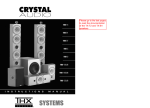Download Monitor Audio GX200
Transcript
GXC 150 GXC 350 Owners Manual GX-FX Contents Page Introduction 2 Unpacking 4 Plinth Fixing 4 Spiked Foot 5 Grilles 5 Bi-Wiring 6 Port Bungs 7 Positioning 8 AV Positioning 8 2 Channel Positioning 10 Fixing the GX-FX to a Wall 10 Setting up the GX-FX 11 Specifications 12 Owner Information 13 monitoraudio.com 1 Introduction The new Gold GX Series is a completely ‘ground up’ design featuring advanced driver technologies and materials amalgamated to form a real world, yet truly esoteric speaker range. Our engineers set their sights high, by attempting to harness the amazing sonic characteristics demonstrated by the prestigious Platinum series. The GX focuses on honesty, there are no smoke and mirrors here, just meticulous attention to detail and passion at every step of the design process. That attention to detail is evident within every component part, manufactured from only the finest materials, cast and machined to exacting tolerances. Whilst incredibly rigid, and as a result stronger, the curved panels also reduce standing waves, eliminating un-wanted sound from being reflected back. The result is a perfect, life-like mid-range character, without a hint of unwanted resonances. Radial internal braces, aided by single bolt-through driver technology, enhance cabinet rigidity and provide additional front to back bracing, while maintaining consistent tension for the driver. This in turn reduces excessive vibration from the driver and cabinet combined, ensuring lower coloration across the entire frequency spectrum. Developed from the renowned C-CAM® material, the new ribbed RST® cone profile has been developed to give incredible rigidity from the lowest possible mass. The result is a stiffer cone and significant reduction in break up modes, to produce a much purer sound overall. Sturdy die-cast alloy chassis’ have been designed incorporating improved venting properties to keep the driver cool as well as reduce internal pressure. The new design C-CAM® Ribbon transducer has been employed to propel high frequency reproduction to well beyond 60 kHz, at least two octaves beyond the threshold of human hearing. Subtle nuances and harmonic content present in high definition 24 bit/192kHz recordings, ensure the full audio experience is faithfully conveyed as intended. Ribbon tweeter technology is very different to traditional domed tweeter designs. Without a traditional voice coil, the moving diaphragm is incredibly light, responding instantly to the smallest level of detail. Our team of engineers invested many hours evaluating and listening to crossover components selecting those which, in the end, simply sound the best. Polypropylene film capacitors, air core and laminated steel core inductors have been utilized to maintain the best possible signal integrity. High quality gold plated terminals are mounted to a very sturdy die-cast alloy terminal panel. They are located low down on the rear of the cabinet to ensure speaker placement and cable connection simple, particularly on floor-standing models. Beautiful piano finish cabinets combine no less than 11 layers of lacquer with meticulous hand polishing to obtain the perfect mirror shine, while real wood finish cabinets are hand veneered after cabinet construction to ensure precise grain matching on every pair. The beautiful grain definition and rich colour variations of Bubinga and modern, Dark Walnut, contrast the more traditional Natural Oak finish and blend with any interior style or décor. Stylish magnetic grilles without visible fixings, add simplicity and refinement to a thoroughly classy overall appearance. Die cast metal base plinths for the GX200 and GX300 provide a very sturdy and rigid foundation. Machined metal, adjustable spiked feet are utilised with the GX200/300 floorstanders and floorstand; hand milled to meticulous quality standards. Solid ‘bullet’ spikes, hand machined from hi-tensile steel and then chrome plated for a fine finish are provided for use on carpeted floors. Non slip rubber pads are incorporated for use on hard or solid wood flooring. 2 Owners Manual The GX range consists of two bookshelf/stand mount monitors in a typical two way configuration, while the two floor-standing models move to being pure three way designs. For the first time, the Gold series is presented with two centre channel speakers to enhance the number of possible system configurations. The diminutive GXC 150 is a two way design incorporating a ribbon transducer and two 5.5” bass drivers. The GXC 350 in contrast, is a serious ‘no compromise’ performance option featuring a ribbon transducer, a 4” dedicated mid-range driver, and two 6.5” bass drivers. FX duties are offered in equally high performance with the GX-FX, mono-pole/ di-pole loudspeaker. Monitor Audio have successfully blended superior technology making the new GX series the embodiment of refinement, beautiful styling, innovation and astounding sonic excellence. Once again, Monitor Audio has a new class leader in the shape of Gold GX. Main Features • New C-CAM® Ribbon transducer design – providing extension to a class leading 60KHz. • New 5.5” and 6.5” bass drivers with C-CAM® cone – larger piston area offering higher efficiency and better dynamics. • New 4” dedicated mid-range driver with C-CAM® cone and under-hung voice coil for very low distortion. • RST® Cone profile, for improved diaphragm rigidity and reduction in distortion. • Die-cast Alloy chassis design for amazing rigidity and lower reflection properties. • HiVe® port technology offers for smoother air-flow for a superior transient response and tighter bass • Single bolt through driver systems, for increased overall bracing, rigidity and driver/baffle de-coupling. • Die-cast alloy terminal panel arrangement with high quality bi-wire terminals and high end spade type, Pureflow® Silver link cables. • Pureflow® Silver internal cabling. • High quality crossovers with premium grade Polypropylene film capacitors used throughout. • Large radius cabinet edges provide low diffraction and smoother overall frequency response. • Curved cabinet profile for increased rigidity and reduced internal standing waves. • Hand selected premium quality wood veneers or high gloss piano finishes. • Rigid 20mm MDF construction throughout, employing both radial and cross-bracing techniques for high rigidity and ensuring low cabinet colouration. • Invisible magnetic grille fixing offers clean visual styling when used without the grille. Metal mesh grille design to give low diffraction – resulting in improved off axis dispersion. • Full 3-way design (GX200, 300 & GXC 350) • Die-cast alloy plinth structures and adjustable feet with provision for both hard and carpet floors (GX200 and 300 only). monitoraudio.com 3 Unpacking Ensure there is plenty of clean floor area around where you are proposing to unpack the loudspeakers. Remove any lose components from the packaging (feet, bolts, plinths, etc) and invert the carton. Lift the carton up and remove the packaging end cap. Remove the tape from the bag(s)revealing the bottom of the cabinet(s). With the GX50 and GX100, stand the cabinets upright and remove the remaining packaging end cap and bag(s). Place the cabinets on the stands and position them according to instructions on page 8. With the GX200 and GX300, fit the plinths and feet before proceeding any further. GX 200/ 300 Plinth Fixing Fit the plinths and spiked feet to the base of each speaker. All fixings are supplied. Refer to page 5. The plinths are provided for stability as well as improving the acoustic performance of the speakers. Due to the tapered shape of the cabinets, it is not recommended to install them without the plinths fitted as the speakers are likely to be unstable. Plinth Bolt Spiked Foot For Wooden/Hard Floors (GX200 & 300 only) The foot comes pre-assembled for use on hard/solid floors or where spikes are inappropriate. All that is required is fixing them into the plinths. This is achieved by screwing the feet fully into the 2 threaded holes in each half of the plinth. With great care turn the cabinet the right way up. Place the cabinet in the desired location, checking that it is level on all sides. If slightly off-level, unscrew the foot at the lowest point and check again. Continue this process until the cabinet is fully level. Use the locking nuts (illustrated on page 4) on each foot to fix the feet in place and to stop any unwanted vibrations. For Carpeted Floors (GX200 & 300 only) If being installed on carpeted floors, remove the spike from the packaging and fix it into the foot assembly, as illustrated. Please ensure there are no hidden wires under the carpet that could be damaged by the spikes. Spike Foot With great care turn the cabinet the right way up. Place the cabinet in the desired location, checking that it is level on all sides. If slightly off-level, unscrew the foot at the lowest point and check again. Continue this process until the cabinet is fully level. Use the locking nuts (illustrated on page 4) on each foot to fix the feet in place and to stop any unwanted vibrations. Plinth Grilles Lock Nut Washer Locking nut The grilles are held invisibly in place by magnets in the cabinet itself (except GX-FX). When fitting, firstly ensure they are the correct orientation (badge at the bottom) and offer them up to the cabinet. The magnets should them pull them into position, but it may need some fine adjustment to ensure it is square on the cabinet. The GX-FX comes with the grilles factory fitted. When removing them, carefully prise them away from the cabinet with the tips of your fingers. There are three separate grilles fitted to each GX-FX cabinet. CAUTION: Always remove the grilles before attempting to move or lift the loudspeakers. 4 Owners Manual monitoraudio.com 5 Bi-Wiring How it Works Port bungs Bi-wiring is accomplished via separate pairs of terminals on the loudspeaker. In the case of the GX Series, the bottom terminals connect to the bass driver(s) and the top terminals connect to the tweeter in 2 way loudspeakers, or the mid and tweeter in 3 way loudspeakers. The normal function of a loudspeaker crossover is to guide appropriate frequencies to the appropriate driver/tweeter. Low frequencies to the bass drivers, mid frequencies to the mid/bass drivers and high frequencies to the tweeter. Fundamentally a loudspeaker crossover varies the impedance seen by the speaker and by the power amplifier. The situation is such that when the full range musical signal is applied to the terminals of a full-range speaker system, the bass driver(s) only receives low frequency signals, the mid driver receives the mid band frequency signals and the tweeter only gets sent high frequency signals. This means that if separate speaker cables are connected to the low frequency terminals, and the high frequency terminals, not only have the drive units and the frequency’s directed and divided for them, but the two separate speaker cables will now also carry different signals, the bass cable mostly the lows, and the tweeter cable mostly the highs. Once the high and low frequencies have been separated in this fashion, the strong current pulses and surges demanded by bass drivers when reproducing bass or drums, will not interact with the delicate sounds of a flute or cymbal. The Effects In a single wired system, unwanted mechanical and electrical resonances manifest as distortion at both sets of speaker terminals. Due to the impedance of the speaker cables, these distortions will not be entirely cancelled by the amplifier. Instead, they modulate between the two crossovers, and degrade sound quality. When bi-wiring, this interaction is minimised as signal distortion is ‘seen’ at the amplifier’s output where it can be more effectively cancelled. Bi-wiring therefore presents a ‘cleaner’ signal at both the low frequency and high frequency speaker terminals, and because the high and low frequencies have already been separated, each has a minimal effect on the other - in essence the bass does not overpower delicate treble. WARNING: Care must be taken not to insert the port bungs too far into the port, as this may result in the foam bung being lost inside the cabinet. If the loudspeaker is to be installed in a small room, typically 9 sqM ( 80 sqFT), or a room known to reproduce accentuated bass response, it may be desirable to fit port bungs. However, experimentation is recommended with positioning of the loudspeaker in the room prior to fitting. To optimise performance from the loudspeaker it is important to ensure the loudspeaker is not positioned too close to a wall or near the corners of a room (refer to the suggestions on pages 8 and 10). If the positioning of the loudspeaker is predetermined by room aesthetics or layout, or you find you have accentuated bass, please move on and read point 1 for the GX50/ GX100 and point 2 for the GX200/ GX300. 1. Where bookshelf/ stand-mount speakers (GX50 & GX100) are to be sited in close proximity (less than 8 inches/ 20cm) to a rear wall (such as on a bookshelf, positioned in a cabinet or on a stand sloce to a wall), we recommend fitting port bungs to the ports. This will reduce the bass ‘boom’ sometimes termed as overhang, and assist the loudspeakers to reproduce their best performance under these environmental conditions. ‘Boom’ is generally caused when bass energy from the loudspeaker ‘excites’ room modes and causes an accentuation at a particular frequency, or number of frequencies. 2. Where floor-standing loudspeakers (GX200 & GX300) are to be sited in close proximity (closer than 18 inches/ 45cm) to a rear wall, we recommend fitting the port bungs. This will reduce the bass ‘boom’ sometimes termed as overhang and assist the loudspeakers to reproduce their best performance under these environmental conditions. This is caused when bass energy from the loudspeaker ‘excites’ room modes and causes an accentuation at a particular frequency, or number of frequencies. When fitting port bungs the overall bass extension will not be reduced, however bass energy/ output around the port tuning frequency will be reduced. This has the effect of reducing bass ‘boom’ while increasing bass clarity and apparent agility. Experimentation is highly recommended. In terms of the audible benefit, bi-wiring, provides more clarity and detail to the midrange and high frequencies. Often the bass will become faster and tighter. Focus and staging will improve as well. In all, this is a very effective and desirable improvement and is highly recommended by Monitor Audio. WARNING: When bi-wiring always remove the cable jumpers between the terminals before connecting any cables. 6 Owners Manual monitoraudio.com 7 Positioning AV Positioning The illustrations below show optimal positioning and various suggested room layouts for AV applications. For advice on configuring a 2 channel system, please refer to page 10. The front, and in some cases rear, floor standing and stand mounted speakers should ideally be positioned approximately 6 - 9 feet apart (1.8m - 2.5m) and a minimum of 10 inches (25cm) from the wall. 44 - 60° 135 150 ° When playing music, if the sound is too bass heavy or there is bass boom generated in the room, experiment by moving the speakers slightly further away from the rear/ corner walls. Alternatively, then try fitting the supplied port bungs (not included in the GX-FX or GXC 150/ 350). Refer to Page 7 for information on fitting the port bungs. The GX Centre should be positioned so that it is pointing directly at you, in your viewing position, and at approximate ear height. If positioned below or above ear height, use rubber feet (small feet supplied) to angle the speaker slightly. The GX-FX should be positioned in accordance with the following illustrations and approximately 2 feet (60cm) above ear height when in your listening position. For information on fixing them to a wall and configuration, please refer to pages 10 and 11. NOTE: When using 2 pairs of GX-FX in a 7.1 system, set the rear surround left speaker to ‘Right’ and the rear surround right to ‘Left’. This is required due to tweeter phasing. All four speakers need to be set to di-pole mode. ° 10 -1 60° ° 10 -1 44 - 90 60° 90 44 - 5.1 system with surround speakers on the rear wall. Floor standing/ stand mounting speakers can also be used. 135 150 ° 5.1 system with surround speakers on the side wall. Floor standing/ stand mounting speakers can also be used. 8 Owners Manual 7.1 system with GXFX’s for surround and rear surround. Floor standing/ stand mounting speakers can also be used. monitoraudio.com 9 2 Channel Positioning Setting up the GX-FX When arranging a 2 channel system, the listening position and the loudspeakers should form an equilateral triangle. The speakers should be positioned approximately 6 - 10 feet (1.8 - 3m) apart. The ideal distance from the rear wall varies depending on the speaker (see list below), however, they need to be a minimum of 3 feet (91cm) from the side walls. The Gold GX-FX’s are independent speakers that can be tailored to be either left or right handed at the flick of a switch. Likewise, they can be operated in either di-pole or monopole modes. The default factory setting is mono-pole. • GX50 and GX100 8 - 18 inches (20 - 45cm) • GX200 18 - 24 inches (45 - 60cm) • GX300 upto 36 inches (91cm) Experimentation is strongly advised when initially setting up the speakers, as environment and personal preference differ with every installation. If there is insufficient bass for example, try moving your speakers closer to a wall. The opposite approach is recommended if there is excess bass. Also see the information on page 7 refering to Port Bungs. If stereo imaging is being lost, try ‘toeing’ them in slightly. The sound should appear to originate from the centre point between the speakers, not the actual speakers themselves. Fixing the GX-FX to a wall CAUTION: Always determine where the GX-FX will be fixed and the structure of the wall. For safety reasons, if unsure of your ability to provide a secure and safe fixing, do not attempt to fix these speakers to a wall. Instead, please obtain the services of a competent and qualified trades person. CAUTION: Ensure that water pipes or electricity cables do not run behind where the wall plate is going to be secured. Work from secure steps and avoid trailing wires. NOTE: We do not supply wall fixing screws and plugs with the GX-FX. Please only use suitable fixings for the type of wall construction the GX-FX’s will be fixed to. To fix the GX-FX’s to a wall, we would recommend using the wall fixing template provided within the packaging carton. Fix the wall plate to the wall, connect the speaker cables, and 12v trigger cables (if being used) and hang the cabinet on the wall plate. In mono-pole mode, only the main driver and tweeter will be active. In di-pole mode, the main tweeter is disengaged and the side drivers and tweeters are active. The front firing tweeters are out of phase with the other tweeter and mid/bass unit. It is recommended to implement this configuration when using two pairs GX-FX as part of a 7.1 channel system, with the GX-FX’s taking up positions on side and rear walls. Please note, it is essential they are positioned correctly when used in a 7.1 channel system. Please refer to the switch positioning images on pages 8 and 9. NOTE: Before adjusting any switches, please ensure that the speaker wires are disconnected from the loudspeakers or amplifier. This will help to protect the amplifier. Tweeter Attenuation Switch. This switch adjusts the level of the main high frequency tweeter unit. In the middle position, there is no attenuation. Placed in the ‘-’ position, the high frequencies will be attenuated by 3dB. Placed in the ‘+’ position, the high frequencies will be boosted by 3dB. Location Switch. This switch is used when determining the location of the GX-FX’s. Please refer to the illustrations on pages 10 & 11 for correct positioning. This will only make a difference when in ‘di-pole’ mode. Mono-pole/ Di-pole Switch. This switch determines the actual mode of the GX-FX. When part of 5.1 systems as a rear speaker, set the switch to monopole. If part of a 7.1 system as side speakers, set the switch to di-pole. If using 4 GX-FX’s (side and rear) set them all to di-pole mode. Please see the illustrations on pages 8 & 9 to determine the setting of the ‘Location Switch’ depending on system set up. If you are using the 12v trigger, set the switch to monopole mode. The trigger will switch a relay to enable the di-pole mode. 12 volt Trigger. (Not shown) This feature is present on some AV amplifiers. It is possible to customise the 12v trigger to switch the speakers to di-pole for certain sources. For example, multichannel music should be listened to in mono-pole mode, however, movies should be listened to in di-pole mode. This feature automates the switching between the two modes. Please refer to your AV amplifier manual for further instruction. 10 Owners Manual monitoraudio.com 11 Product Details Model ................................................................. 2 Way GX50 Date of Purchase ................................................ Dealer Details Complete Dimensions Inc Terminals, Plinths & Spikes HxWxD mm (inches) Cabinet Dimensions HxWxD mm (inches) 7.5 (16.5) 300 x 170 x 290 11 13/16 x 6 11/16 x 11 7/16 300 x 170 x 263 11 13/16 x 6 11/16 x 10 3/8 1 x 5.5” RST® bass / mid driver 1 x C-CAM® ribbon H.F transducer 2.3kHz Bass Reflex. HiVe® port system 50 - 100 100 109.8 8 86 55Hz – 60kHz Product Serial No ................................................ Product Weight kg (Ibs) Drive Unit Compliment Crossover Frequency Bass Alignment Recommended Amplifier Requirements (W) Power Handling RMS (W) Maximum SPL (dBA) Nominal Impedance (ohms) Sensitivity (dB) 1W@1m Frequency Response System Format Owner Information ........................................................................................................................................... 60 - 120 120 112.6 8 88 42Hz – 60kHz 2 Way GX100 Address ............................................................................................................................. 9.9 (21.75) 362 x 210 x 330 14 3/8 x 8 1/4 x 13 362 x 210 x 303 14 3/8 x 8 1/4 x 11 15/16 1 x 6.5” RST® bass / mid driver 1 x C-CAM® ribbon H.F transducer 2.7kHz Bass Reflex. HiVe® port system Dealer Name ..................................................................................................................... Monitor Audio reserves the right to alter specifications without notice. 100 - 150 150 114.5 8 89 35Hz – 60kHz 3 Way GX200 Telephone Number ............................................................................................................ 22.2 (48.9) 995 x 274 x 370 39 3/16 x 10 13/16 x 14 9/16 951 x 170 x 300 37 7/16 x 6 11/16 x 11 13/16 2 x 5.5” RST® bass driver 1 x 4” RST® mid-range driver 1 x C-CAM® ribbon H.F transducer L.F - M.F: 400Hz M.F - H.F: 2.6kHz Bass Reflex. HiVe® port system e-mail address ................................................................................................................... L.F - M.F: 790Hz M.F - H.F: 2.3kHz Bass Reflex. HiVe® port system 100 - 200 200 116.8 8 90 30Hz – 60kHz 3 Way GX300 2 x 5.5” RST® bass driver 1 x C-CAM® ribbon H.F transducer 2.8kHz Sealed Cabinet 100 - 150 150 111.5 8 89 55Hz – 60kHz 2 Way GXC 150 2 x 6.5” RST® bass driver 1 x 4” RST® midrange driver 1 x C-CAM® ribbon H.F transducer L.F - M.F: 800Hz M.F - H.F: 2.3kHz Sealed Cabinet 100 - 200 200 113.8 8 90 40Hz – 60kHz 3 Way GXC 350 1 x 6.5” RST® bass driver 2 x 4” C-CAM® midrange driver 1 x C-CAM® ribbon H.F transducer 2 x 25mm Gold C-CAM® dome H.F Bi-Pole: 2.3kHz Di-pole: 2.6kHz Sealed Cabinet 50 - 100 100 110.8 8 87 60Hz – 60kHz 2 Way GX-FX 1105 x 317 x 370 43 1/2 x 12 1/2 x 14 9/16 6 (13.25) 172 x 461 x 330 6 11/16 x 18 1/8 x 13 9.9 (21.75) 254 x 581 x 360 10 x 22 7/8 x 14 3/16 254 x 581 x 333 10 x 22 7/8 x 13 1/8 11.9 (26.1) 310 x 390 x 168 12 3/16 x 15 3/8 x 6 5/8 310 x 390 x 160 12 3/16 x 15 3/8 x 6 5/16 172 x 461 x 303 6 11/16 x 18 1/8 x 11 15/16 27.2 (59.9) 1060 x 210 x 330 41 3/4 x 8 1/4 x 13 2 x 6.5” RST® bass driver 1 x 4” RST® midrange driver 1 x C-CAM® ribbon H.F transducer For the 5 years manufacturer’s warranty and to be entered into our monthly prize draw, please visit the online registration form at: www.monitoraudio.com m o n i t o r a u d i o . c o . u k Monitor Audio Ltd. Unit 2, 24 Brook Road Rayleigh, Essex SS6 7XJ England Tel: +44 (0)1268 740580 Fax: +44 (0)1268 740589 Email: [email protected] monitoraudio.com Designed in the United Kingdom © 2011. Version 1






















